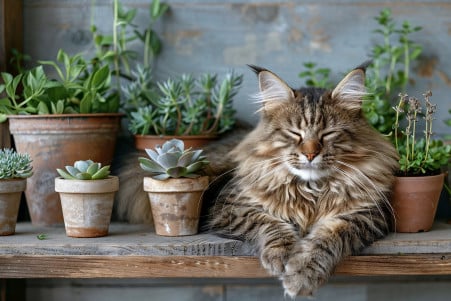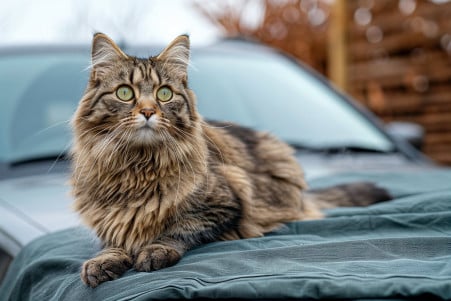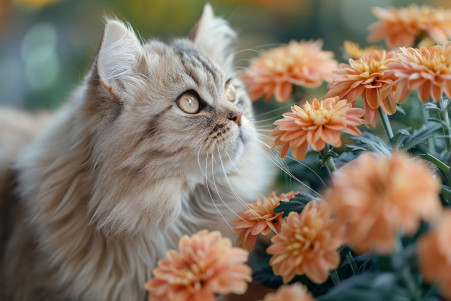Can You Use Mothballs to Repel Cats? The Dangers and Other Options
6 June 2024 • Updated 6 June 2024

If you're dealing with a cat problem in your yard or home, you might have come across the idea of using mothballs to keep them away. But can you use mothballs to repel cats? Mothballs are not an effective or safe way to repel cats. While the strong smell of naphthalene or paradichlorobenzene in mothballs can bother cats' heightened sense of smell, the toxic fumes pose serious risks to cats and humans if ingested or inhaled. There are other cat deterrents that are both safer and more humane.
This article will look at scientific studies that have investigated the effectiveness and potential health risks of using mothballs to repel cats. By drawing on the expertise of veterinarians, toxicologists, and animal behaviorists, you'll learn why this method is problematic from both an ethical and safety standpoint. In addition, we'll cover other options that have been shown to work and are safe for pets so you can keep cats away without putting them or your family at risk.
Can you use mothballs to repel cats?
Mothballs Are Toxic to Cats and Humans
Mothballs are made with either naphthalene or paradichlorobenzene, both of which are toxic to cats and humans. According to the Environmental Protection Agency, these chemicals are pesticides that are regulated because of their toxicity.
In cats, inhaling the fumes of mothballs or ingesting them can cause liver and kidney failure, brain swelling, coma, and death, according to Pets on Mom.com. Symptoms of mothball poisoning in cats include lethargy, vomiting, diarrhea, loss of appetite, and seizures.
Humans, especially children, are also at risk of mothball toxicity. Catster explains that mothballs can cause respiratory problems and skin irritation. If a cat is exposed to or ingests mothballs, it's important to seek immediate veterinary treatment to prevent life-threatening poisoning.
Even though the smell of mothballs may keep some cats away, the health risks associated with using them as a cat deterrent are not worth the potential reward. There are other cat deterrents that are safer and more humane that can be used to protect a garden without putting pets and people at risk.
Safe and Humane Alternatives to Cat Deterrents
If you want to deter cats from your garden, flower beds, or other parts of your property, there are several safe and humane methods you can use. Alley Cat Allies suggests using scent-based deterrents, such as scattering fresh orange or lemon peels, organic citrus-scented sprays, vinegar, or essential oils of lavender, lemongrass, citronella, or eucalyptus.
WikiHow also suggests planting cat-repelling herbs, including coleus canina (also known as the "scaredy cat" plant), lavender, rosemary, pennyroyal, chives, and lemon balm. You can also use physical barriers like plastic carpet runners, chicken wire, or lattice fencing to make garden beds less attractive to cats.
In addition, motion-activated ultrasonic devices and sprinklers can be effective deterrents, according to The Humane Society of the United States. If you want to encourage cats to stay away from your property, you can also try providing them with a designated outdoor shelter or litter box.
By using these humane methods, you can keep your outdoor spaces free of cats without putting felines at risk. This can help you find a way to live in harmony with the cats in your area.
Positive Reinforcement Training for Cats: A Better Way to Train
Positive reinforcement training is another option that can help you train your cat without resorting to negative methods. As the Humane Society of Huron Valley explains, positive reinforcement training involves giving your cat treats, affection, or play when they exhibit the behaviors you want to encourage. This makes it more likely that they will continue to exhibit those behaviors in the future.
For example, if you want your cat to come when you call them, you can give them a treat when they come after you call their name. Feline Behavior Solutions notes that it's important to figure out what motivates your cat the most, whether it's food, toys, or attention, and use that as a reward. In addition, you need to be consistent, patient, and make sure that you're using rewards that are meaningful to your cat.
Positive reinforcement is more effective than punishment, which can cause your cat to experience fear, stress, and other negative side effects. As WebMD says, "Positive reinforcement is the only way to go" when it comes to training cats. By using positive reinforcement to encourage the behaviors you want, you can discourage your cat from doing things like jumping on counters or scratching furniture.
This method of training will help you shape your cat's behavior in a way that's kind and respectful while also helping you strengthen your bond with your cat through positive interactions. With the right training, you can help your cat learn to live in harmony with you and your garden.
Designing a Cat-Friendly Garden: Spaces for Cats and Plants to Thrive
Designing a garden that is friendly to cats can help ensure that your outdoor space is safe and stimulating for your feline friends. As noted by Garden Betty, including features like cat-friendly climbing structures, hiding places, and play zones can help keep cats entertained and prevent them from damaging other parts of the garden.
The ASPCA suggests planting non-toxic plants that are safe for cats, including catnip, cat grass, asters, and cucurbit vegetables. Alley Cat Allies recommends using cat-proof fencing, cloches, or enclosures to protect certain areas of the garden while still allowing cats to access them.
It’s important to make sure that you’re not planting anything that could be toxic to cats and that you’re giving them other ways to express their natural behaviors. By creating a garden that meets the needs of both the plants and the cats, you can make sure that your feline friends and your garden can coexist peacefully.
Finding a Middle Ground: How to Keep Your Garden Safe and Respect Cats
It can be difficult to keep a garden healthy when there are cats around, but it’s important to make sure that both the garden and the cats are taken into account. A multi-faceted approach that includes physical barriers, scent deterrents, and cat-friendly areas can help keep gardens safe while still respecting cats.
It’s also important to make sure that pet owners are taking responsibility for their animals and that the community is educated about the importance of spaying/neutering and not abandoning cats. By looking for solutions that are humane, gardeners can find ways to protect their outdoor spaces while still making sure that the needs of all creatures are met.
By taking a balanced approach, it is possible to create a situation where cats and carefully tended gardens can coexist.


